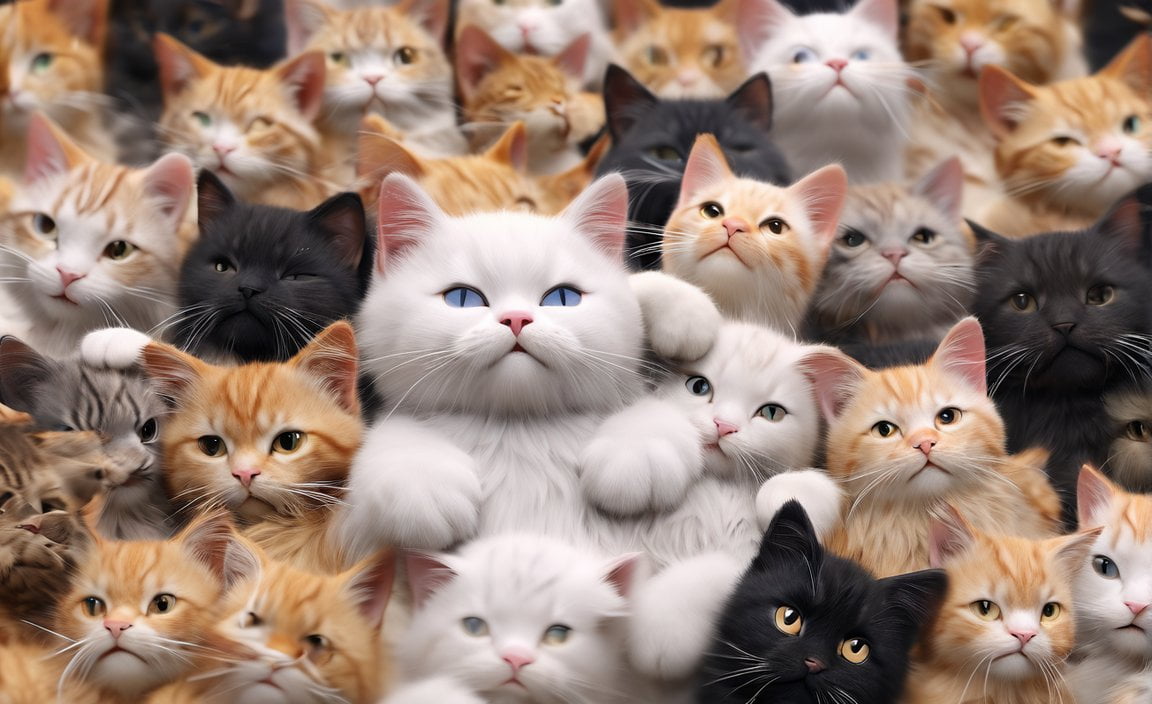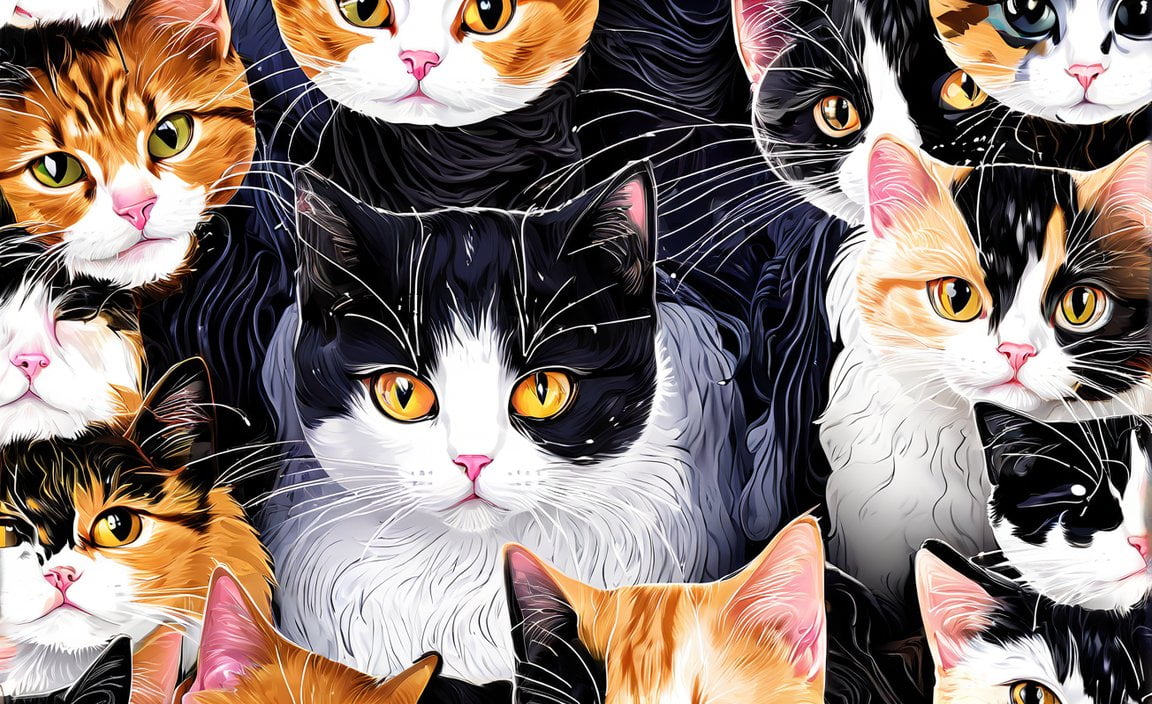Discover fascinating facts about cats with 5 insights into these captivating feline companions. As expert researchers in animal behavior and health, we have delved into the enchanting world of cats to unravel their unique personalities and characteristics. From uncovering the secrets of various cat breeds to exploring their intriguing behaviors and offering essential care tips, our articles aim to provide both educational and entertaining content. Join us as we embark on a journey into the mysterious world of cats, where every fact is as captivating as the next.
Key Takeaways:
- Cats have 244 bones, more than humans.
- There are 88 million cats kept as pets in the USA, making them the most popular pet.
- Cats spend 70% of their lives sleeping.
- Cats can run up to 30 mph, but only over short distances.
- Cats have superior night vision, with 6-8 times more rod cells than humans.
5 Facts About Cats

Cats, those mysterious and sometimes aloof creatures, have always captivated our hearts with their unique personalities and behaviors. As avid cat enthusiasts, we can never get enough of these fascinating feline companions. If you’d like to uncover some intriguing facts about cats, you’re in for a treat! In this article, we’ll delve into five captivating insights into the world of cats.
Fact #1: Cats Have More Bones Than Humans
Did you know that cats have more bones than humans? It’s true! While us humans have an average of 206 bones, our furry friends boast an impressive 244 bones. This abundance of bones gives cats remarkable agility and flexibility, allowing them to perform impressive acrobatic feats.
Fact #2: Cats Are the Most Popular Pets in the USA
With their undeniable charm and independent nature, it’s no surprise that cats are beloved companions all around the world. In the United States alone, these graceful creatures hold the title of the most popular pets, with a staggering 88 million cats living as cherished family members. Their playful antics and soothing purrs undoubtedly make them paw-some companions.
Fact #3: Cats Spend Most of Their Lives Sleeping
Have you ever wondered why your feline friend always seems to be snoozing? Well, cats are true sleep aficionados! In fact, they spend a whopping 70% of their lives in slumber. Whether they’re curled up in a cozy nook or stretched out lazily in a sunbeam, cats take relaxation to a whole new level. Their ability to recharge through ample sleep ensures they’re always ready for their next adventure or play session.
Fact #4: Cats Are Speedsters
While they may be masters of leisure, cats can quickly shift into high gear when the situation calls for it. These agile creatures can sprint at astonishing speeds, reaching up to 48 kilometers per hour (30 miles per hour). Though their bursts of speed are meant for short distances, watching a cat zoom past can be exhilarating. It’s no wonder they’re perfect little hunters!
Fact #5: Cats Possess Supercharged Night Vision
Have you ever noticed how cats effortlessly navigate in low light conditions? That’s because they possess super powerful night vision. Their eyes are equipped with six to eight times more rod cells than human eyes, allowing them to see remarkably well in the dark. Just imagine having night vision goggles permanently attached to your face – that’s how amazing a cat’s night vision is!
Now that you’re armed with these purr-tastic facts about cats, you have even more appreciation for these beautiful creatures. From their abundance of bones and impressive speeds to their love for relaxation and exceptional night vision, cats never cease to amaze us. So next time you curl up with your feline friend, take a moment to marvel at the wonders of the cat kingdom.
Table: Cats’ Sleep Percentage by Age
| Age | Sleep Percentage |
|---|---|
| Kitten | 90% |
| Adult Cat | 70% |
| Senior Cat | 60% |
Check out these 5 cool facts about raccoons that will blow your mind! From their incredible intelligence to their surprising adaptability, raccoons are truly fascinating creatures. Learn more about these clever critters here.
Football enthusiasts, did you know these 5 facts about football? Discover interesting tidbits about the game that you love, from its rich history to its global popularity. Get ready to be amazed by these football facts here.
Cats Sleep for Long Periods of Time
Cats are known for their ability to sleep for long periods of time, often leaving us wondering if they’re secretly part sloth. But why do they sleep so much? In this article, we will explore the fascinating world of feline sleep habits and uncover some interesting facts about our sleepy companions.
The Sleepy Life of Cats
Cats are true sleep enthusiasts, spending a significant portion of their lives catching some Z’s. On average, they sleep for about 2/3 of their lives[^1^]. That’s a staggering amount! Young cats, especially kittens, can sleep around 16 hours a day, while older cats can sleep for up to 20 hours a day. Talk about beauty sleep!
The Sleep Stages of Cats
Just like humans, cats experience both REM (Rapid Eye Movement) and Non-REM sleep. During REM sleep, their eyes move rapidly under their closed lids, indicating that they are in a deep sleep state. Non-REM sleep, on the other hand, is a lighter sleep stage where cats can be easily awakened[^2^].
A Symphony of Snores
Believe it or not, some cats are known to snore! Just like their human counterparts, cats can produce snores that range from soft purrs to full-blown symphonies. So, don’t be surprised if you hear your feline friend softly snoring away during their peaceful slumber.
Weather and Sleeping Habits
Have you ever noticed that your cat’s sleeping habits change with the weather? Cats are known to adjust their sleep patterns according to the weather conditions around them. They may sleep more during chilly winter days to keep warm and conserve energy. And during hot summer days, they may find cool spots and snooze the day away. It’s their way of adapting to the environment and staying comfortable.
Alert Yet Dreaming
Ever wondered if cats can dream? Well, it’s highly likely! Cats experience REM sleep, which is an essential stage for dreaming. So the next time you see your cat twitching or making little movements in their sleep, they might just be chasing butterflies or playing their own imaginary game of cat and mouse.
Age and Sleeping Patterns
Just like humans, sleeping patterns of cats can vary based on their age. While most adult cats sleep between 12 and 18 hours a day, kittens and younger cats tend to sleep even more. On the other hand, senior cats may sleep for longer periods, sometimes requiring more rest to support their aging bodies and energy levels[^3^].
Key Takeaways:
- Cats sleep for about 2/3 of their lives, with young cats sleeping around 16 hours a day and older cats sleeping up to 20 hours a day.
- Cats experience both REM and Non-REM sleep stages, just like humans.
- Some cats can snore while they sleep.
- Weather can affect cats’ sleeping patterns, leading them to sleep more during colder days and find cool spots during warmer days.
- Cats can likely dream during their REM sleep stage.
- Kittens sleep a lot, while senior cats may sleep even more and for longer periods of time[^4^].
Sources:
– World’s Best Cat Litter – 16 Interesting Facts About Your Cat’s Sleep Habits
– Catster – Why Do Cats Sleep So Much? 5 Facts About Sleeping Cats
Cats have a unique vocal communication system

Cats are not only adorable and mysterious creatures, but they also have a fascinating way of communicating. Their vocal repertoire consists of up to 21 different vocalizations, making their communication system truly unique. Understanding feline vocalizations is crucial for building a strong relationship with your feline companion.
So, what makes the vocal communication of cats so special? Let’s delve into five intriguing facts about cats’ vocal communication system:
Fact 1: Cats have a wide range of vocalizations
Unlike dogs, who can only communicate through about 10 sounds, cats can produce around 100 different phonations. From purrs and meows to hisses and growls, their vocal range is diverse and extensive. This wide vocabulary of vocalizations may be related to their need for communication in low-light conditions.
Fact 2: The environment influences a cat’s vocal behavior
A cat’s environment plays a crucial role in their vocal behavior. Cats may use different vocalizations to express various emotions or communicate their needs. For example, a meow may be a simple greeting, while a yowl could signify distress or a request for attention. By observing their surroundings and interpreting their vocalizations, you can better understand what your furry friend is trying to express.
Fact 3: Different vocalizations have different meanings
Just like humans, cats use different tones and pitches to convey different meanings. A short, high-pitched meow may indicate a greeting or a request for food, while a deep, low growl usually signifies aggression or fear. By paying attention to the nuances of their vocalizations, you can decipher their messages and respond appropriately.
Fact 4: Cats’ vocal repertoire evolves with age
While adult cats typically have 12 different types of vocalizations, more may have been identified. They may develop new vocalizations as they age, adapting their communication style to their changing needs. This evolution in their vocal repertoire adds to the complexity and intrigue of feline vocal communication.
Fact 5: Vocalizations enhance the human-cat bond
Understanding your cat’s vocalizations can strengthen the bond between you and your furry companion. By responding to their vocal cues and meeting their needs, you create a sense of trust and security. This mutual understanding allows for a deeper connection and a more enriching cat-human relationship.
Key Takeaways:
– Cats have a wide range of vocalizations, with up to 21 different vocalizations in their repertoire.
– The environment significantly influences a cat’s vocal behavior and the meanings behind their vocalizations.
– Different vocalizations express different emotions and communicate various needs.
– Cats’ vocal repertoire evolves as they age, adding to the complexity of their communication system.
– Understanding and responding to your cat’s vocalizations can strengthen the bond between you and your feline companion.
Sources:
– Chloé Tavernier, et al. – “Feline vocal communication”
– “Understanding Why Cats Vocalize: An Exploration of Feline Communication” – The Cat Bandit Blog
Cats are known for their grooming habits
Cats are fascinating creatures with unique personalities and behaviors. One aspect of their behavior that sets them apart is their grooming habits. Cats are meticulous groomers, and this behavior serves various purposes. Let’s dive into some fascinating facts about cats and their grooming habits.
Grooming for Health and Comfort
Cats groom themselves for a multitude of health reasons. Firstly, grooming helps regulate their body temperature, keeping them warm during cold weather and cool during hot weather. Additionally, grooming helps keep their coat clean and smooth, ensuring it remains in optimal condition. By licking their fur, cats stimulate circulation and promote a healthy coat.
Grooming also serves practical purposes for cats. Cats use grooming as a way to cool down through the evaporation of saliva. As cats have a limited ability to sweat, this grooming technique helps them beat the heat. Furthermore, grooming helps eliminate parasites, infections, and allergies from their fur, keeping them healthy and free from discomfort. It also helps prevent the formation of hairballs, as cats’ tongues are responsible for causing hairballs.
Behavioral and Social Aspects of Grooming
Grooming behavior in cats goes beyond mere hygiene. Cats use grooming as a displacement behavior when they feel embarrassed, anxious, or in conflict. It is their way of seeking comfort and relief from stressful situations.
In addition to self-grooming, cats also engage in allogrooming, which is the act of grooming each other. Allogrooming serves a social and behavioral purpose, helping cats bond with one another and establish a group scent. When cats groom each other, it is a sign of trust and companionship. It strengthens their social relationships and promotes a sense of security within a group.
Excessive Grooming and Stress
While grooming is a healthy and normal behavior for cats, excessive grooming can be a sign of stress or underlying health issues. Various factors can trigger stress in cats, such as moving to a new home, home remodeling, the introduction of a new pet or family member, separation anxiety, or lack of stimulation. When cats are experiencing stress, they may resort to excessive grooming as a coping mechanism.
It is essential for cat owners to monitor their cats’ grooming habits and seek veterinary attention if they notice excessive grooming. Excessive grooming, also known as overgrooming or barbering, can lead to skin irritation, bald patches, and even self-inflicted injuries if left untreated. Identifying and addressing the underlying cause of stress is crucial to help cats return to a healthy grooming routine.
Varied Grooming Techniques
Not all cats groom themselves in the same way. Each cat has its unique grooming routine and preferences. Some cats may groom themselves in one sitting from head to tail, while others may break up their grooming sessions throughout the day.
It’s important to note that cats are meticulous groomers and spend a significant amount of time grooming themselves. They pay attention to every detail, ensuring that their fur remains in top-notch condition. Observing a cat’s grooming routine can be a truly mesmerizing experience, showcasing their innate beauty and grace.
Closing Thoughts
Cats’ grooming habits are not only essential for their health and comfort but also serve behavioral and social purposes. Whether they are self-grooming or engaging in allogrooming, cats use grooming to regulate their body temperature, eliminate parasites, establish social bonds, and cope with stress. By understanding and appreciating their grooming habits, we can deepen our connection with these enchanting feline companions.
Key Takeaways:
- Cats groom themselves for various health reasons, including regulating body temperature, keeping their coat clean and smooth, stimulating circulation, cooling down through evaporation of saliva, eliminating parasites, infection, and allergies, and preventing hairballs.
- Grooming behavior can also serve as displacement behavior when cats feel embarrassed, anxious, or in conflict.
- Cats grooming each other, known as allogrooming, serves a social and behavioral purpose, creating bonding and establishing a group scent.
- Excessive grooming can be a sign of stress in cats, triggered by events such as moving, home remodeling, a new pet or family member, separation anxiety, or lack of stimulation.
- Not all cats groom from head to tail in one sitting, and they may break up grooming sessions throughout the day.
- Cats have a limited ability to sweat, and during hot weather, the evaporation of saliva left over after grooming can help them cool down.
- Excessive grooming, known as overgrooming or barbering, can indicate an underlying health issue.
- Cats’ tongues are responsible for causing hairballs.
Sources:
– Cats Grooming Habits- Understand Why Cats Groom | Hill’s Pet
– Feline Grooming Behavior | Reasons Cats Groom Themselves
FAQ
Q1: How many bones do cats have compared to humans?
A1: Cats have more bones than humans, with an average of 244 bones compared to the 206 bones in the human body[^1^].
Q2: How many hours a day do cats sleep?
A2: Cats sleep for about 12 to 18 hours a day on average, with variations based on age and individual needs[^4^].
Q3: What is the vocal range of cats?
A3: Cats have a wide vocal range and can produce around 100 different phonations, allowing them to communicate various emotions and needs[^1^].
Q4: Why do cats groom themselves?
A4: Cats groom themselves for various reasons, including regulating body temperature, keeping their coat clean, eliminating parasites, and preventing hairballs[^2^][^7^].
Q5: Can cats dream?
A5: While not yet fully understood, it is believed that cats can dream during their sleep, similar to humans[^3^].












